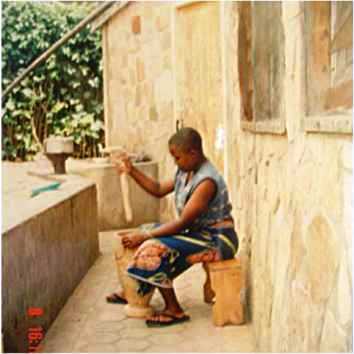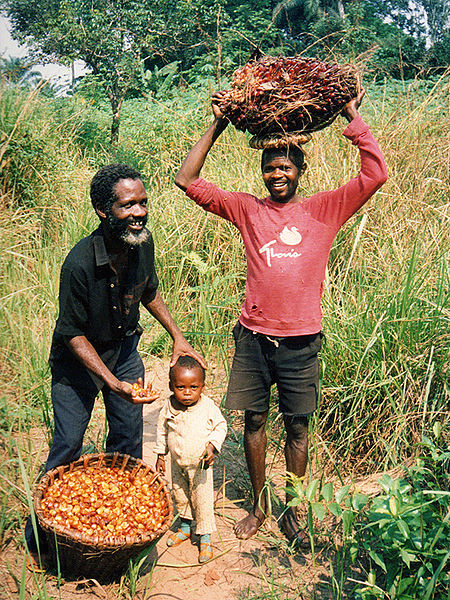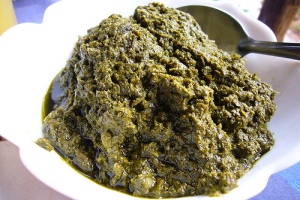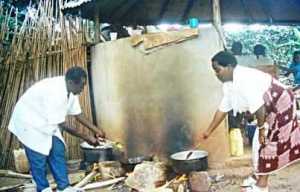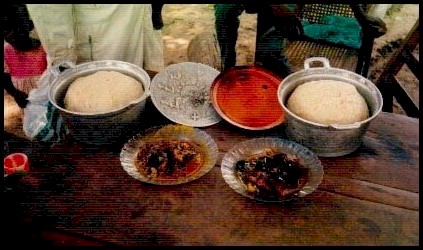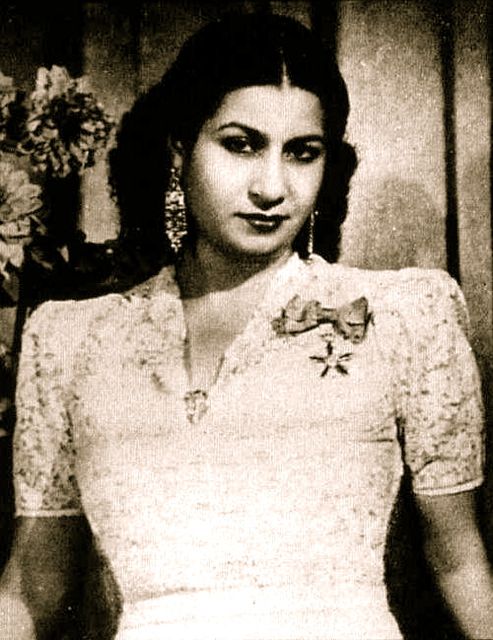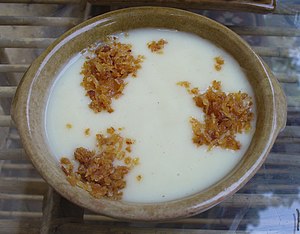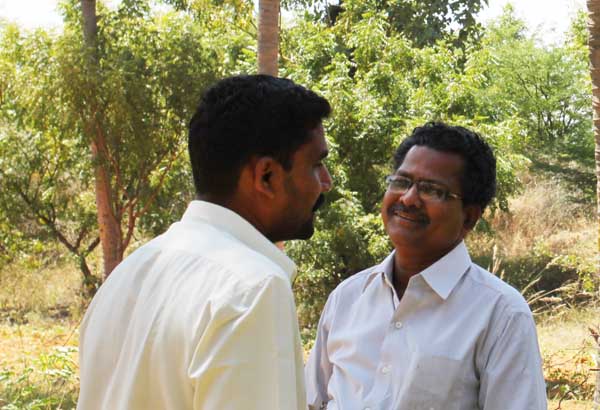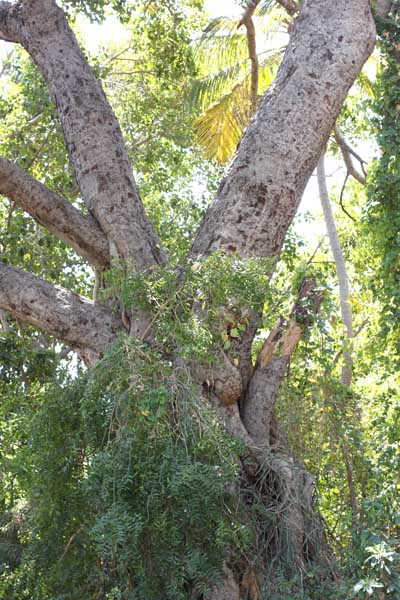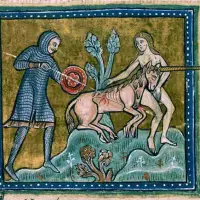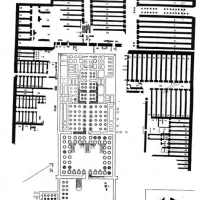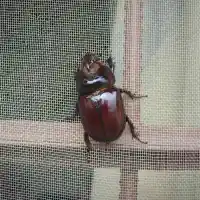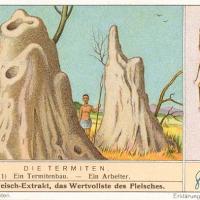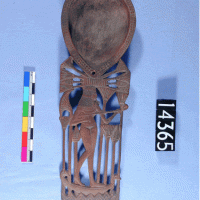
A bowl of kishk topped with sautéed onions, an Egyptian dish made with thickened milk or yogurt and topped with fried onions. It is described in the following text as a 19th century treat. In the village where I lived, it was still a great treat that was made by some of the older women. It is a dish that transcends religious sects and socio-economic strata, as well as ethnicities. (Photo credit: Wikipedia)
Manners and Customs of The Modern Egyptians, by E. Lane, is a two-volume set filled with lore about Egypt during the author’s time (1834). And although it makes for fascinating reading, the book is now largely ‘put down’ by post-colonial theorists who are troubled by the Orientalist mind-set of Lane and his colleagues.
Nevertheless, taken at descriptive value, it – as so much of the colonial literature of exploration – provides views both into lifestyles of local people at the time and their (presumed) thoughts – as well as mindsets of the authors themselves; of colonial mentality.
The following excerpt describes common practices during Orthodox Easter time in Egypt (1834), and includes a recipe for kishk, which was eaten as part of the celebrations for Good Friday. Kishk is still a very popular dish, eaten year-round, and I remember the delicious kishk that was made in the Izba (hamlet) in Upper Egypt where I lived while doing research.
Salted fish ( فسيخ), lettuce, and onion are also eaten as part of this spring celebration, which is commonly organized as a picnic. It is said that these practices can be traced back to ancient Egypt, though I cannot find solid information about this. Nevertheless, it is a celebration that encompasses both Muslims and Christians and transcends socio-economic strata.
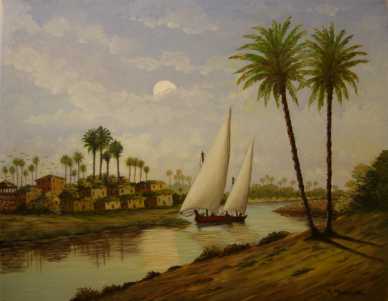
An izba (hamlet) in Upper Egypt, similar to the one in which I lived. The green matter on the roofs is fodder, crop leavings, and oven fuel. Source – oilpaintingsonline.com, the painting is by Ahmed Moustafa, of Alexandria.
Of particular interest in the following description, is the melding of Muslim, Coptic, and non-religious activities into one ceremony – called, as still today, Shamm al-Nasim (شم النسيم – literally, ‘sniffing the breeze’). Some of the activities described below are still found, while others, such as ritual washing with a particular plant, are no longer to be commonly found.
Until the presidency of Nasser (mid-20th century), there was a large Jewish community in Cairo and it is possible that the Jewish celebration of Passover, which takes place during the same time period in Egypt, also incorporated aspects of the Shamm al-Nasim celebration.
IT is remarkable that the Moos’lims of Egypt observe certain customs of a religious or superstitious nature at particular periods of the religious almanac of the Copts [Orthodox Christians of Egypt]; and even, according to the same system, calculate the times of certain changes of the weather.
Thus they calculate the period of the Khum’a’see’n [khamsiin], when hot southerly winds are of frequent, occurrence, to commence on the day immediately following the Coptic festival of Easter Sunday, and to terminate on the Day of Pentecost (or Whitsunday); an interval of forty-nine days.
The Wednesday next before this period is called Ar’ba’a Eiyoo’b, or Job’s Wednesday. Many persons, on this day, wash themselves with cold water, and rub themselves with the creeping’ plant called raara’a Ei-yoo’b, or ghoobey’ra (inula Arabica, and inula undulata), on account of a tradition which relates that Job did so to obtain restoration to health. This and other customs about to be mentioned were peculiar to the Copts; but are now observed by many Moos’lims in the towns, and by more in the villages.
The other customs just alluded to are that of eating eggs, dyed externally red or yellow or blue, or some other colour, on the next day (Thursday); and, on the Friday (Good Friday), a dish of khul’tah, composed of kishk*, with foo’l na’bit**, lentils, rice, onions, &c.
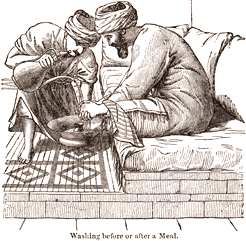
Washing before a meal, a necessary task. Source: Lane, Manners and Customs…
* Kishk is prepared from wheat, first moistened, then dried, trodden in a vessel to separate the husks, and coarsely ground with a hand-mill: the meal is mixed with milk, and about six hours afterwards is spooned out upon a little straw or bran, and then left for two or three days to dry. When required for use, it is either soaked or pounded, and put into a sieve, over a vessel; and then boiling water is poured on it: what remains in the sieve is thrown away: what parses through is generally poured into a saucepan of boiled meat or fowl, over the fire: some leaves of white bete, fried in butter, are usually added to each plate of it.
** foo’l na’bit are Beans soaked in water until they begin to sprout, and then boiled.
On the Saturday, also, it is a common custom of men and women to adorn their eyes with kohhl. This day is called Sebt en-Noo’ r (Saturday of the Light); because a light, said to be miraculous, appears during the festival then celebrated in the Holy Sepulchre in Jerusalem.
A custom termed Shemm en-Nesee’m* (or the Smelling of the Zephyr) is observed on the first day of the Khum’a’see’n. Early in the morning of this day, many persons, especially women, break an onion, and smell it; and in the course of the forenoon, many of the citizens of Cairo ride or walk a little way into the country, generally northwards, to take the air, or, as they term it,smell the air, which, on that day, they believe to have a wonderfully beneficial effect. The greater number dine in the country.
This year (1834), they were treated with a violent hot wind, accompanied by clouds of dust, instead of the nesee’m: but considerable numbers, notwithstanding, went out to smell it.
*شم النسيم
Source: Edward William Lane – An Account of the Manners and Customs of the Modern Egyptians, Written in Egypt during the Years 1833, -34, and -35, partly from Notes made during a Former Visit to that Country in the Years 1825, -26, -27, and 28. In Two Volumes
[First published 8 April 2012 > Revised here.]
Related articles
- Happy Passover. Happy Easter. Joyeuses fêtes de Pessah et de Pâque. (gjnashen.wordpress.com)






